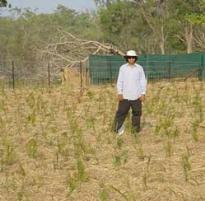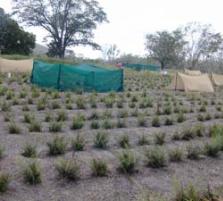Arsenic-eating fern grows well in CQ
Published on 20 January, 2005
A Central Queensland University study into an arsenic-eating fern has revealed its ability to grow on arsenic contaminated sites in Central Queensland.
The recent findings that the arsenic-eating fern (syn Chinese Brake fern) can help remediate thousands of arsenic contaminated sites triggered intensive research on the fern throughout the world, including here in Central Queensland.
 Principal investigator, CQU’s Dr Nanjappa Ashwath (pictured) said the aim was to find out if the fern could grow in the tropics, as it naturally occurs in temperate regions of Australia, particularly in Victoria.
Principal investigator, CQU’s Dr Nanjappa Ashwath (pictured) said the aim was to find out if the fern could grow in the tropics, as it naturally occurs in temperate regions of Australia, particularly in Victoria.
“Results to date suggest that the fern can grow well in the tropics, is relatively drought tolerant and prefers neutral to alkaline soils,” Dr Ashwath revealed.
A field trial involving 3500 ferns was established on an abandoned cattle dip site at Stanwell Power Station in collaboration with Stanwell’s Michelle Hanrahan. The ferns were grown in soil treated with or without lime, and were drip irrigated.
The rate at which the fern accumulates arsenic, its root depth and effects of various chemical and agronomical treatments on arsenic uptake rate are currently being investigated by CQU Honours student, Sara Hanggi, with the view to establishing its usage on arsenic-contaminated sites in the tropics.
“When the technology is fully developed, it will help clean up thousands of arsenic-contaminated cattle dips and citrus orchards in an environmentally-friendly manner,” Dr Ashwath said.
Arsenic contamination has occurred worldwide due to indiscriminate use of arsenical pesticides (during early to mid-1900s), the use of phosphate fertilisers, industrial use of arsenic in timber treatment, mining, the occurrences of natural events such as volcanoes and the very nature of the rocks from which the soils are formed.
 Arsenic trioxide, an inorganic arsenical, was widely used for cattle tick control during 1900-1950. Dipping cattle in an arsenical solution was first undertaken at St Lawrence, in Queensland, in 1895.
Arsenic trioxide, an inorganic arsenical, was widely used for cattle tick control during 1900-1950. Dipping cattle in an arsenical solution was first undertaken at St Lawrence, in Queensland, in 1895.
Dr Ashwath believes there are over 1600 dip sites in northern New South Wales, and a similar number of dip sites are known to occur in Queensland.
Dr Ashwath's project was jointly funded by Stanwell and a University collaborative research grant to CQU's Professor David Midmore.

